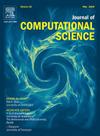Real-time virtual intervention for simple and serial coronary artery disease using the HarVI framework
IF 3.7
3区 计算机科学
Q2 COMPUTER SCIENCE, INTERDISCIPLINARY APPLICATIONS
引用次数: 0
Abstract
Virtual planning tools that provide intuitive user interaction and immediate hemodynamic feedback are crucial for cardiologists to effectively treat coronary artery disease. Current FDA-approved tools for coronary intervention planning require days of preliminary processing and rely on conventional 2D displays for hemodynamic evaluation. Immersion offered by extended reality (XR) has been found to benefit intervention planning over traditional 2D displays. Building on our previous work (Tanade and Randles, 2024), we introduce HarVI, a coronary intervention planner that leverages machine learning for real-time hemodynamic analysis and extended reality for intuitive 3D user interaction. The framework uses a predefined set of 1D steady state computational fluid dynamics (CFD) simulations to perform one-shot training for our machine learning-based blood flow model. In a two-center cohort of 73 patients, 70 with focal lesions and 3 with serial lesions, we calculated fractional flow reserve — the gold standard biomarker of ischemia in coronary disease, flow rate, and wall shear stress using HarVI and 1D CFD models. HarVI was shown to almost perfectly recapitulate the results of 1D CFD simulations through continuous validation scores. In this study, we establish a machine learning-based process for virtual coronary treatment planning with an average turnaround time of just 62 min — around an order of magnitude improvement over literature standards, thus reducing the required time for one-shot training to less than one working day.
使用HarVI框架对简单和系列冠状动脉疾病进行实时虚拟干预
能够提供直观的用户互动和即时血液动力学反馈的虚拟规划工具对于心脏病专家有效治疗冠状动脉疾病至关重要。目前 FDA 批准的冠状动脉介入规划工具需要数天的初步处理,并依赖传统的二维显示器进行血液动力学评估。与传统的二维显示器相比,扩展现实技术(XR)提供的沉浸式体验有利于干预规划。在我们之前的工作(Tanade 和 Randles,2024 年)基础上,我们推出了 HarVI,这是一种冠状动脉介入规划器,它利用机器学习进行实时血流动力学分析,并利用扩展现实技术进行直观的三维用户交互。该框架使用一组预定义的一维稳态计算流体动力学(CFD)模拟,对我们基于机器学习的血流模型进行一次性训练。在一个由 73 名患者组成的双中心队列中(其中 70 名患者有局灶性病变,3 名患者有序列性病变),我们使用 HarVI 和一维 CFD 模型计算了分数血流储备(冠心病缺血的金标准生物标志物)、流速和壁剪应力。通过连续验证评分,HarVI 几乎完美地再现了一维 CFD 模拟的结果。在这项研究中,我们建立了基于机器学习的虚拟冠状动脉治疗规划流程,平均周转时间仅为 62 分钟,比文献标准提高了约一个数量级,从而将单次训练所需的时间减少到一个工作日以内。
本文章由计算机程序翻译,如有差异,请以英文原文为准。
求助全文
约1分钟内获得全文
求助全文
来源期刊

Journal of Computational Science
COMPUTER SCIENCE, INTERDISCIPLINARY APPLICATIONS-COMPUTER SCIENCE, THEORY & METHODS
CiteScore
5.50
自引率
3.00%
发文量
227
审稿时长
41 days
期刊介绍:
Computational Science is a rapidly growing multi- and interdisciplinary field that uses advanced computing and data analysis to understand and solve complex problems. It has reached a level of predictive capability that now firmly complements the traditional pillars of experimentation and theory.
The recent advances in experimental techniques such as detectors, on-line sensor networks and high-resolution imaging techniques, have opened up new windows into physical and biological processes at many levels of detail. The resulting data explosion allows for detailed data driven modeling and simulation.
This new discipline in science combines computational thinking, modern computational methods, devices and collateral technologies to address problems far beyond the scope of traditional numerical methods.
Computational science typically unifies three distinct elements:
• Modeling, Algorithms and Simulations (e.g. numerical and non-numerical, discrete and continuous);
• Software developed to solve science (e.g., biological, physical, and social), engineering, medicine, and humanities problems;
• Computer and information science that develops and optimizes the advanced system hardware, software, networking, and data management components (e.g. problem solving environments).
 求助内容:
求助内容: 应助结果提醒方式:
应助结果提醒方式:


